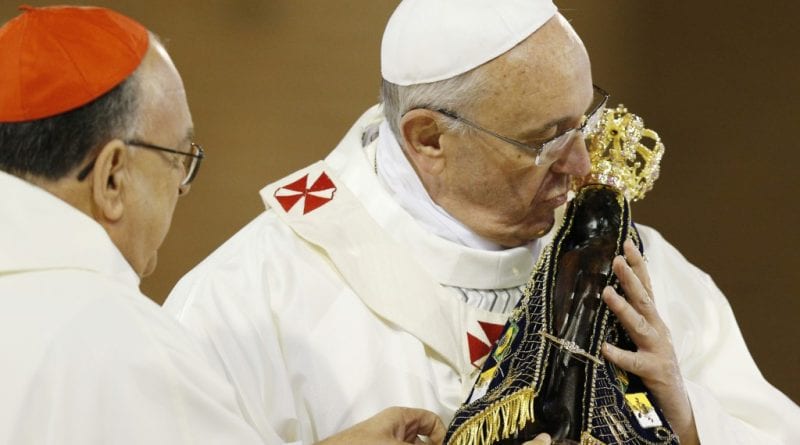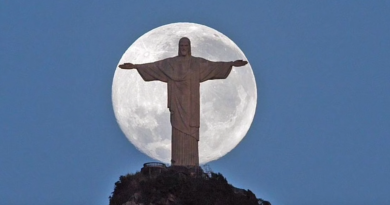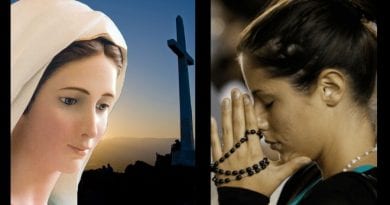Pope recounts story of miraculous statue. “After having recovered both parts, the image of the Virgin of Aparecida became so heavy that they could not move it. “
Follow Mystic Post on Facebook
After having recovered both parts, the image of the Virgin of Aparecida became so heavy that they could not move it. The fishermen then caught so much fish that they were forced to return to the port, because their boats almost sunk. This was the first miracle attributed to Our Lady of Aparecida.
(Vatican Radio) Pope Francis has sent a message to the National Youth Meeting at the Sanctuary of Aparecida in Brazil, inviting young people to turn their lives into leaven for a better Brazilian society.
His message came at the conclusion of the “Rota” (Way) 300 project, which closed on July 29 with a large celebration at the sanctuary. The initiative celebrated 300 years since the discovery of the statue of Our Lady of Aparecida in the Paraiba do Sul River.
Pope Francis told the young people that Mary is a sign of hope and that she knows the difficulties awaiting young people. He also encouraged them to live with a missionary spirit.
“Dear friends, in the midst of daily uncertainties and insecurities and in the midst of the precariousness created by unjust situations, you have one certainty. Mary is a sign of hope who will impel you with a great missionary drive. She knows the difficulties with which you live. Her attention and motherly care help you know that you are not alone.”
The Holy Father also recalled the Brazilian story of the poor fishermen, who, after an unfruitful fishing expedition in the Paraiba do Sul River, cast their nets one more time and discovered to their surprise a broken statue of Our Lady, encrusted with mud. They first found the statue’s body and then its head.
“As I told the Brazilian bishops in 2013, this story holds an important symbolism. What was divided has been reunited, just like the heart of those fishermen and colonial Brazil once divided by slavery, realities which found unity in the faith, which the black statue of Our Lady has inspired.”
Pope Francis then invited the young people to let their hearts be transformed by the encounter with the Mother of Aparecida.
“May she transform the ‘nets’ of your lives – nets of friendship, social networks, material and virtual nets – realities which are often divided, into something more meaningful. May they become communities! Missionary communities ‘going out into the world’! Communities which are light and leaven for a more just and fraternal society.”
The Pope also recalled his message to the CELAM Meeting earlier this year, asking young people “not to be afraid to take risks and to work to build a new society, imbuing social, political, economic, and university environs with the force of the Gospel!”
“Do not be afraid to fight corruption, and do not let yourselves be seduced by it! Trusting in the Lord, whose presence is the source of abundant life, and under Mary’s mantle, you can rediscover the creativity and strength of being protagonists for a culture of unity and, therefore, create new paradigms to guide the life of Brazil.”
Pope Francis concluded his message with a prayer.
“May Our Lady – who in her youth knew how to courageously embrace the call of God for her life and go forth to those most in need – walk ahead of you, guiding you in all her ways!”
About the Miracle
This miracle occurred in the second half of October in the year 1717, when the count of Assumar and governor of the infantry of São Paulo and Minas of Ouro, Don Pedro de Almeida, was passing by the city of Guaratinguetá, located in the valley of Paraiba, during a trip to Vila Rica. The inhabitants of Guaratinguetá decided to celebrate a great feast in honor of Don Pedro de Almeida, and though it was not a good season for fishing, they cast their nets in the Paraiba River, in an attempt to get some fish for the event. The fishermen Domingos Garcia, João Alves y Filipe Pedroso prayed asking the intercession of Our Lady. After several attempts, they went downstream until they arrived at the port Itaguaçu. When they were about to abandon their attempt at fishing, João Alves threw his nets another time and in place of a fish, they picked up the body of a statue of Our Lady of the Immaculate Conception, but without the head. Once again casting the net, they caught the head, which fit perfectly with the body of the statue.
After having recovered both parts, the image of the Virgin of Aparecida became so heavy that they could not move it. The fishermen then caught so much fish that they were forced to return to the port, because their boats almost sunk. This was the first miracle attributed to Our Lady of Aparecida.
History Wiki
According to the account of the discovery of the statue in October 1717, Dom Pedro de Almeida, Count of Assumar and Governor of the Province of São Paulo and Minas Gerais, was passing through the area of Guaratinguetá, a small city in the Paraíba river valley,[7]during a trip to Vila Rica, an important gold mining site.
As the people of Guaratinguetá decided to hold a feast in his honour, three fishermen, Domingos Garcia, João Alves, and Filipe Pedroso went down to the Paraíba waters to fish. The fishermen prayed to Our Lady of the Immaculate Conception that God would grant a good catch. The fishermen, having a run of bad luck, cast their nets in the River Paraiba and dragged up a headless statue of the Virgin Mary. They also salvaged the head and, according to the legend, then netted plenty of fish.[4] After cleaning the statue, they found that it was a black version of Our Lady of the Immaculate Conception.[1] Legend has it that when the fishermen recovered the body, then the head, the slender figure of the Aparecida Virgin became so heavy that they couldn’t budge it.[2]
The fishermen named the statue Nossa Senhora da Conceição Aparecida (English: Our Lady of the Appeared Conception).[8][not in citation given] Neighbors began to venerate the statue, which came to be known as Our Lady of Aparecida, and devotion grew. The first chapel was built in 1745.[4]
Devotion to the statue grew rapidly, particularly among Afro-Brazilians, not only for its black Madonna status, but also because it was reported to have performed a miracle for an enslaved young man.
Over the years following its discovery, veneration of the Virgin invoked as Aparecida increased as many miracles were attributed to her.[2] For the following fifteen years, the statue remained within Filipe Pedroso’s family, and neighbors came to venerate it. Stories of Our Lady of Aparecida’s miracles were spread throughout Brazil, and the Pedroso family built her a chapel which soon became too small for so many worshippers. In 1737 the priest of Guaratinguetá built her a chapel[2] on the Morro dos Coqueiros (Hill of Coconut Palms), where public visits began in July 1745.
The number of worshippers increased dramatically, and in 1834 work on a larger church was begun; this became known as the “Old Basilica” when work on the even larger “New Basilica” was started in 1955; it received pontifical approbation in 1980.[2]
The image[edit]
According to a local tale the clay statue was imported from Portugal; others say that it was made by Frei Agostinho de Jesus, a monk from São Paulo known for crafting artistic sacred images in clay. The small statue is less than three feet tall.[3][9] The image was made around 1650, and must have been underwater for years, since it lost its original polychromy.[7]
The image is dark brown, and covered by a stiff dark blue robe of richly embroidered thick cloth emblazoned with the flags of Brazil and the Vatican City State with golden clasps. An imperial crown was added in 1904.[7]
A bronze replica of the same image is sponsored by the Embassy of Brazil to the Vatican and was approved for installation within the Gardens of the Vatican City under the mandate of Pope Francis, officially held on 3 September 2016.
Assault on the image
The image became the source of religious conflicts between Catholics and Protestants, primarily driven by non-mainline churches identified with charismatic, evangelical, or fundamentalist theology, including all branches of Pentecostalism, due to the nature of Catholic Marian devotion associated with the religious image.
Pieces of the vandalized Marian image taken in 1978.
On May 16, 1978, a person identified as a member of a Protestant sect took the statue from its niche on the Basilica after the last Mass of the day. He was chased by guards and some of the church goers.[15] As he was caught, the statue fell to the ground breaking to pieces;[15] a group of artists and artisans pieced it together again.[15]
On her feast day in 1995, a public holiday, an incident later known as “kicking of the saint” took place when televangelist Sérgio Von Helder (or Helde), of the Universal Church of the Kingdom of God (UCKG), insulted and kicked a replica of Our Lady of Aparecida, and said that “it could not do anything for you”, on a late-night religious program broadcast by UCKG television station Rede Record.[16][17] On the following day, Rede Globo’s Jornal Nacional denounced the incident, causing a nationwide commotion. The event was perceived by Catholics as a major act of religious intolerance, causing a public outcry. Several temples of the UCKG were targeted by protesters, and Von Helder was transferred to South Africa until the end of the controversy.[3][18]
Since you’re here …
… we have a small favor to ask. More people are reading Mystic Post than ever but advertising revenues across the media are falling fast. And unlike many news organisations, we haven’t put up a paywall – we want to keep our journalism as open as we can. So you can see why we need to ask for your help. Mystic Post’s independent journalism takes a lot of time, money and hard work to produce. But we do it because we believe our perspective matters – because it might well be your perspective, too.
High quality journalism is essential intellectual nourishment. The generosity of providing such a service without a paywall deserves recognition and supportGiacomo P, Italy
I’ve been enjoying Mystic Posts for several years now. Today, when so much seems to be going wrong in the world, Mystic Post is working hard to provide truthful Catholic news. I want to support that Robb R. UK
I appreciate there not being a paywall: it is more democratic for the media to be available for all and not a commodity to be purchased by a few. I’m happy to make a contribution so others with less means still have access to information. Annonymous Donator
If everyone who reads our reporting, who likes it, helps to support it, our future would be much more secure.
Thank you
$1.00 $10,00 $25.00 $1,000 – Any contribution makes a big difference.
Make a contribution
With a $25.00 donation receive a free miraculous medal. We can really use it – THANKS!






